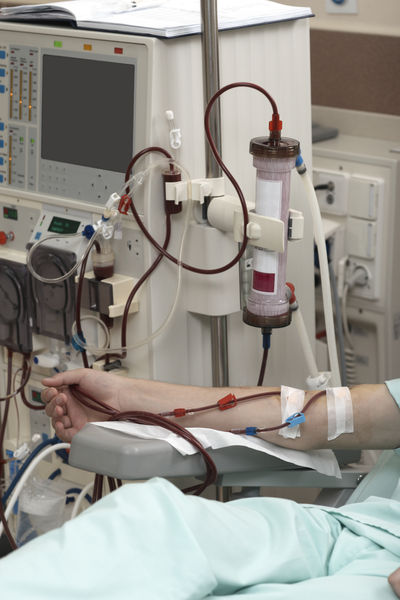Dialysis

Dialysis is a process by which small molecules in a solution are separated from large molecules. Dialysis has a number of important commercial and industrial applications and plays a crucial role in maintaining the health of humans. For some people, in fact, the term dialysis refers to a specific kind of medical treatment in which a machine (the dialysis machine) takes on the functions of a human kidney. Dialysis machines have made possible the survival of thousands of people who would otherwise have died as a result of kidney failure.
Dialysis is a specific example of a more general process known as diffusion. Diffusion was first described by Scottish chemist Thomas Graham (1805–1869) around 1861. Graham studied the movement of molecules of different sizes through a semipermeable membrane. (A semipermeable membrane is a thin sheet of material that allows some substances to pass through—or diffuse—but not others.) Many tissues in the human body are semipermeable membranes. Graham discovered that some substances, such as the sodium and chloride ions of which ordinary table salt is composed, diffuse through a semipermeable membrane up to 50 times as fast as other substances, such as ordinary table sugar.
Today we know the reason behind Graham's observation. Semipermeable membranes are not actually solid sheets of material. Instead, they contain tiny holes too small to be seen by the unaided eye. Those holes are just large enough to allow tiny particles like sodium and chloride ions to pass through, but they are too small to permit the passage of large molecules, such as those of sugar.
In a typical dialysis experiment, a bag made of a semipermeable membrane is filled with a solution to be dialyzed. The bag is then suspended in a stream of running water. Small particles in the solution within the bag gradually diffuse across the semipermeable membrane and are carried away by the running water. Larger molecules are essentially retained within the bag. By this process, a highly efficient separation of substances can be achieved.
Kidney dialysis
The kidney is a dialyzing organ. Blood that enters the kidney has a great variety of materials in it; some are essential (important, necessary) to human life, others are harmful to life. Proteins circulating in the blood, for example, have many critical bodily functions, such as protecting against disease and carrying "messages" from one part of the body to another. But other materials in blood are waste products of bodily functions that must be eliminated. If they remained in blood, they would cause illness or death. Urea, formed during the breakdown of proteins, is one such compound.
Blood that passes through the kidney is dialyzed to separate essential compounds from harmful compounds. Protein molecules are too large to go through semipermeable membranes in the kidney and are retained in the blood. Urea molecules are much smaller than protein molecules. They pass through those membranes and into urine, in which they are excreted from the body.
The dialysis machine. Sometimes a person's kidneys may be damaged by disease or physical injury. They are no longer able to dialyze blood properly. At one time, people in this situation died because of the accumulation of poisonous materials (such as urea) in their blood. Then, in the 1910s, scientists invented an artificial kidney machine that could be used to dialyze blood. A pioneer in this research was American biochemist John Jacob Abel (1857–1938).
In the kidney machine, blood is removed from a person's arm, passed through a dialyzing system, and then returned to the patient. The machine functions much as a natural kidney would—with one important exception. A natural kidney has a mechanism known as reverse dialysis for returning to the body certain small molecules (primarily glucose) that should not be excreted. The kidney machine is unable to do so, and glucose that it removes must be replaced by intravenous injection.
Electrodialysis
Another form of dialysis is known as electrodialysis. In electrodialysis, an electrical field is set up around a dialysis apparatus. The electrical field causes charged particles in a solution to pass through the semipermeable membrane more quickly than they would without the field. Any large molecules in the solution, though, remain where they are.
One possible application of electrodialysis is the desalination of water. In this procedure, sodium ions and chloride ions from the salt in seawater are forced out, leaving pure water behind.
[ See also Diffusion ]
salamat (thank you)
Precious Martinez